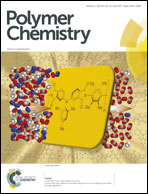A novel method to improve the thermal stability of poly(propylene carbonate)
Abstract
In the present work, a surfactant, the phosphoric ester of poly(ethylene oxide) (10) nonylphenyl (abbreviated as NP-10P throughout the paper), was incorporated into poly(propylene carbonate) (PPC) by melt-blending. Characterization data by TGA and Py-GC/MS have suggested that the obtained PPC/NP-10P complex displays excellent thermal stability compared to pure PPC. The thermal decomposition temperature, with a 5% loss in weight, increases by about 103 °C from 180 °C for PPC to 283 °C for PPC with 15 wt% NP-10P. Furthermore, with only 1 wt% of NP-10P incorporated into the PPC, an increase of about 74 °C in the decomposition temperature is found. The pyrolysis mechanism of PPC before and after modification with NP-10P varies from chain unzipping degradation to chain random scission followed by unzipping degradation. The results of 31P NMR, FTIR and intrinsic viscosity measurements have illustrated that the PPC is end-capped with NP-10P, which leads to the improvement of thermal stability and the change in pyrolysis mechanism of PPC. Moreover, this new finding will facilitate development and widespread applications of this biodegradable material.


 Please wait while we load your content...
Please wait while we load your content...